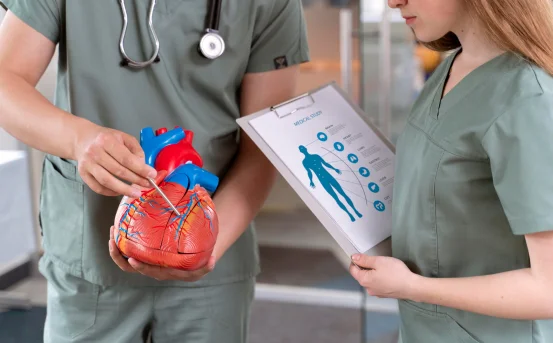Deep Vein Thrombosis (DVT) is a serious medical condition that occurs when a blood clot (thrombus) forms in a deep vein, usually in the legs. These clots can partially or completely block blood flow, leading to pain, swelling, and potentially life-threatening complications like pulmonary embolism (PE). Early recognition of DVT symptoms is crucial for timely intervention and treatment.
Understanding Symptoms of Deep Vein Thrombosis
Before diving into the symptoms, it’s important to understand what DVT is and why it’s dangerous. Veins carry deoxygenated blood back to the heart, and deep veins are located far from the skin surface, often surrounded by muscles. When a blood clot forms in these veins, it can disrupt normal circulation.
The most common site for DVT is the lower leg, but it can also occur in the thigh, pelvis, or even arms. If the clot dislodges and travels through the bloodstream, it can block a vessel in the lungs, resulting in a pulmonary embolism, a potentially fatal event.
Primary Symptoms of Deep Vein Thrombosis
DVT can be deceptive, as some people may have no noticeable symptoms. However, when symptoms do appear, they often occur in one leg and develop suddenly. Below are the most common signs to watch for:
- Swelling in the Leg :- One of the most recognizable symptoms of DVT is swelling in the affected leg. This swelling typically occurs in the calf or thigh and may come on suddenly. The leg may appear larger or feel heavier than usual.
- The swelling usually affects one side only.
- It may extend from the foot to the knee or thigh.
- The skin over the area may feel tight or stretched.
Swelling occurs because the clot obstructs blood flow, causing blood to pool in the affected vein.
- Pain or Tenderness :- Pain in the leg is another hallmark symptom. It can range from a dull ache to sharp cramping, often mistaken for a muscle strain or soreness from exercise.
- The pain usually starts in the calf and can radiate upward.
- It worsens while walking or standing, and may lessen with rest.
- It may be accompanied by tenderness when touching the area.
If you experience persistent leg pain that doesn’t improve with rest or ice, it’s important to consider the possibility of DVT.
- Red or Discolored Skin :- Discoloration is a visible indicator that something may be wrong with the circulatory system.
- The skin over the clot may appear red, purplish, or bluish.
- The area might feel warm to the touch, a sign of inflammation.
- These changes are often localized to the calf or thigh area.
While discoloration can be caused by many conditions, its presence along with pain and swelling raises the suspicion of DVT significantly.
- Warmth Over the Affected Area :- The skin over the clot may feel noticeably warmer than the surrounding area. This warmth is due to inflammation of the vein walls where the clot is present.
- This is usually accompanied by redness or swelling.
- The warmth is often limited to a specific area, usually over the calf or behind the knee.
This symptom is often overlooked or attributed to physical exertion, but in the presence of other DVT signs, it becomes significant.
- Leg Fatigue or Heaviness :- Many individuals with DVT report a heavy or tired feeling in the affected leg. This sensation is more than just routine fatigue; it can feel as though it’s harder to lift or move the leg.
- You may feel sluggish or unable to walk comfortably.
- The fatigue may persist even after rest.
- Activities such as climbing stairs or walking long distances become difficult.
This symptom often develops gradually and may precede more visible signs like swelling or redness.
Less Common But Possible Symptoms
While the above are the most common indicators, some individuals may experience additional symptoms that can signal DVT:
- Cramping in the Calf
- Often described as a charley horse that doesn’t go away.
- Unlike regular cramps, these persist and don’t respond well to stretching or hydration.
- Skin That Is Pale or Bluish
- Some clots cause the skin to appear pale due to reduced blood flow, or blue/purple from pooling blood.
- Visible Veins
- Superficial veins around the clot may become more prominent or dilated, appearing ropey or twisted.
These signs are especially important in people who are at high risk for DVT, such as those who have recently undergone surgery, are immobile, or have a family history of clotting disorders.
When to Seek Medical Attention
The symptoms of DVT can overlap with other less severe conditions, but the risk of complications makes it a medical emergency. If you notice any of the following combinations, it’s critical to see a doctor immediately:
- Sudden swelling in one leg
- Persistent pain or tenderness in the calf or thigh
- Red or warm skin on one leg
- Shortness of breath or chest pain (may indicate pulmonary embolism)
Early diagnosis and treatment can prevent the clot from growing or breaking loose, greatly reducing the risk of a pulmonary embolism.
Conclusion
Deep Vein Thrombosis is not something to take lightly. While it may begin silently, the consequences can be life-altering if ignored. Recognizing the early symptoms of deep vein thrombosis such as leg swelling, pain, discoloration, and warmth can lead to faster diagnosis and potentially life-saving treatment.
If you or someone you know is experiencing these symptoms, consult a healthcare provider immediately. Early intervention can prevent complications and promote a full recovery. Awareness is the first step in protecting yourself from the hidden dangers of DVT.























